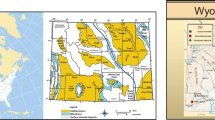Abstract
The U.S. Geological Survey recently completed a digital coal resource assessment model of the Upper Pennsylvanian Pittsburgh coal bed, which indicates that after subtracting mined-out coal, 16 billion short tons (14 billion tonnes) remain of the original 34 billion short tons (31 billion tonnes) of coal. When technical, environmental, and social restrictions are applied to the remaining Pittsburgh coal model, only 12 billion short tons (11 billion tonnes) are available for mining. Our assessment models estimate that up to 0.61 billion short tons (0.55 billion tonnes), 2.7 billion short tons (2.4 billion tonnes), and 8.5 billion short tons (7.7 billion tonnes) could be available for surface mining, continuous mining, and longwall mining, respectively. This analysis is an example of a second-generation regional coal availability study designed to model recoverability characteristics for all the major coal beds in the United States.
Similar content being viewed by others
REFERENCES
Beatty, G., 1849, Niles' national register, Philadelphia: William Ogden Niles, Publ., v. 76, p. 269.
Clark, W. B., and Campbell, M. R., 1905, Origin, distribution, and uses of coal: Maryland Geol, Survey, v. 5, p. 235–236.
Commonwealth of Pennsylvania, 1975–1995, Dept. of Environmental Resources, Annual Report on Mining Activities: Harrisburg, PA, multiple volumes by year.
Eggleston, J. R., Carter, M.D., and Cobb, J.C., 1990, Coal resources available for development—a methodology and pilot study: U.S. Geol. Survey Circ 1055, 15 p.
Energy Information Administration (EIA), 1998a, Coal Industry Annual 1997. U.S. Department of Energy, Washington D.C., p. 15.
Energy Information Administration (EIA), 1998b, EIA Form 7A data [database available from EIA, National Energy Information Center, tele. no: (202) 586-8800].
Energy Information Administration (EIA), 1999, Natural Gas Pipeline Digital Spatial Database, compiled by James Tobin, Washington D.C., available from J. Tobin.
ESRI Inc., 1998, ESRI Data and Maps, Set of 4 CD's available from ESRI.
ESRI Inc., 1999, ArcData OnLine, Census 95 Tiger Data [downloadable from www.esri.com].
Geiser, P. A., and Engelder, T., 1983, The distribution of layer parallel shortening fabrics in the Appalachian Foreland of New York and Pennsylvania; evidence for two non-coaxial phases of the Alleghanian Orogeny, in Williams, H., and Zietz, I., eds., Contributions to the Tectonics and Geophysics of Mountain Chains: Geol. Soc. America, Mem. p. 161–175.
Maryland Bureau of Mines, 1969–1995, Annual Report of the Maryland Bureau of Mines: Maryland Bureau of Mines, Baltimore, v. 47–72.
McColloch, G. H., 1997, West Virginia Geological and Economic Survey, MHST SIS (West Virginia Division of Miners Health, Safety, and Training-Safety Information System) Database Search.
Ohio Division of Labor Statistics, 1945–1946, Coal report: Department of Industrial Relations, Annual Reports 1945–1946.
Ohio Division of Labor Statistics, 1947–1965, Coal and nonmetallic mineral report: Department of Industrial Relations, Annual Reports 1947–1965.
Ohio Division of Labor Statistics, 1966–1981, Annual Reports: Department of Industrial Relations, Annual Reports 1966–1981.
Ohio Division of Labor Statistics, 1982–1993, Mining laws of Ohio: Department of Industrial Relations, 250 p.
Petroleum Information Corp., 1998 [current as of 31 December, 1997], Well History Control System Littleton, Colorado, Petroleum Information Corp. [database available from Petroleum Information Corp., 4100 East Dry Creek Road, Littleton, CO 80122].
Resource Data International, Inc., 1998, COALdat database: Boulder, Colorado, Resource Data International, Inc. [database available from Resource Data International Inc., 1320 Pearl Street, Suite 300, Boulder, CO 80302].
Rohrbacher, T. J., Teeters, D. D., Sullivan, G. L., and Osmonson, L. M., 1993, Coal resource recoverability, a methodology: Bur. Mines Inform. Circ. 9368, U.S. Department of the Interior, Washington, D.C., 48 p.
Ruppert, L. F., Tewalt, S. J., Bragg, L. J., and Wallack, R. N., 1999a, A digital resource model of the Upper Pennsylvanian Pittsburgh coal bed, Monongahela Group, Northern Appalachian Basin coal region, USA: Intern. Jour. Coal Geology, v. 4, p. 3–24.
Ruppert, L. F., Tewalt, S. J., Bragg, L. J., and Wallack, R. N., 1999b, Digital assessment of northern and central Appalachian basin coals: Mining Engineering, v. 49, p. 37–43.
Scharf, J. T., 1882, History of Western Maryland: Regional Publ. Co., Baltimore, v. 2, p. 1434–1435.
Suffredini, C. D., Plis, M. N., Rohrbacher, T. J., and Teeters, D. D., 1994, COALVAL 2.0, A prefeasibility software package for evaluating coal properties using Lotus 1-2-3, release 3.1: U.S. Bur. Mines Open-File Rept. 35-94, U.S. Department of the Interior, Denver, CO.
Tewalt, S. J., Ruppert, L. F., Bragg, L. J., Carlton, R.W., Brezinski, D. K., and Wallack, R. N., 1997, Map showing thickness contours of the Pittsburgh coal bed in Pennsylvania, Ohio, West Virginia, and Maryland; digitally compiled by Tewalt, S., Ruppert, L., Wallack, R., and Weiss, E.; U.S. Geol. Survey Open-File Rept. 97–748, scale 1:425,000, 1 sheet (downloadable from www.usgs.gov).
United States Census Office, 8th Census, 1860, Report on Manufacturers: Eighth Census of the United States, v. 2.
United States Congress, 1789–1822, American State Papers, Class 4, Commerce and Navigation, v. 14–15.
Wood, H.W., Jr., Kehn, T. M., Carter, M.D., and Culbertson, W. C., 1983, Coal resource classification system of the U.S. Geological Survey:U.S. Geol. Survey Circ. 891,U.S. Government Printing Office, Washington, D.C., 65 p.
Author information
Authors and Affiliations
Rights and permissions
About this article
Cite this article
Watson, W.D., Ruppert, L.F., Tewalt, S.J. et al. The Upper Pennsylvanian Pittsburgh Coal Bed: Resources and Mine Models. Natural Resources Research 10, 21–34 (2001). https://doi.org/10.1023/A:1011529430807
Issue Date:
DOI: https://doi.org/10.1023/A:1011529430807




